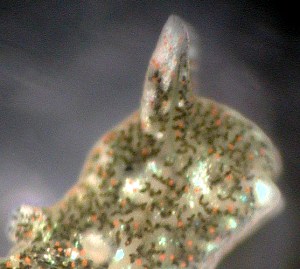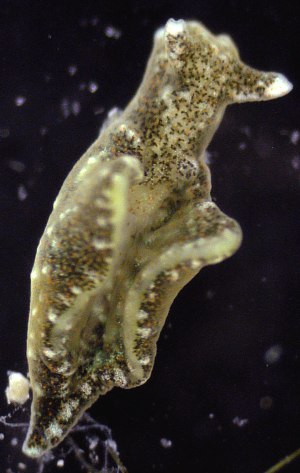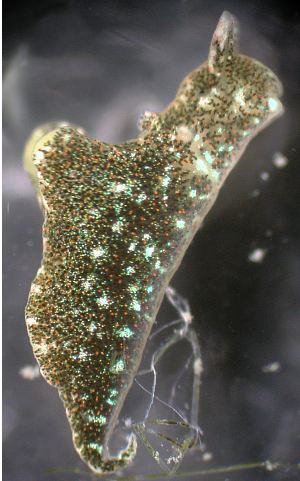
Elysia cf. canguzua
Order: SACOGLOSSA
Superfamily: ELYSIOIDEA
Family: Elysiidae
PHOTO
Gulf of Mexico, Florida. Photo: Anna L. Bass.
Elysia canguzua was described by Marcus (1955) from the coast of Sao Paulo, Brazil. 3 specimens in June 1953, 20 eating Codium in April 1954. Intertidal. He describes the living colour as 'green, due to the branchings of the liver that are disposed in chiefly longitudinal direction. bright red dots are probably cutaneous gands. There are also groups of brilliant blue spots...." They also describe black pigment which is so 'dense inside the rhinophoral fold .. that the rhinophores appear gray in dorsal view' There is also black pigment on the sides of the head and in some animals it borders the parapodia. The 'rhinophores are very long and rabbit's ear-like'.
Until the species is redescribed from Brazil it is not possible to positively identify the photo from Gulf of Mexico as this species. It has no visible black pigment and the rhinophores are not overly large. The whitish-blue patches are distributed much as in Marcus's drawing of E. canguzua.
References:
• Marcus, Er. (1955) Opisthobranchia from Brazil. Boletim da Faculdade de Filosofia, Ciencias e Letras. Universidade de Sao Paulo, Zoologia, 20: 89-261. (Pls. 1-30)
• Marcus, Ev. (1980) Review of western Atlantic Elysiidae (Opisthobranchia Ascoglossa) with a description of a new Elysia species. Bull. Mar. Sci. 30(1): 54-79.


Rudman, W.B., 2002 (October 7) Elysia cf. canguzua [In] Sea Slug Forum. Australian Museum, Sydney. Available from http://www.seaslugforum.net/find/elyscfcang
Related messages
Re: Elysia from Gulf of Mexico
October 9, 2002
From: Kathe R. Jensen
Dear Anna & Bill,
My first thought when I saw this Elysia was that it was E. canguzua (another Marcus species), but I have to admit that I cannot quite remember what it looked like. We found it on Codium, I think in Fort Pierce Inlet, but only one time did we collect more than one specimen. I remember watching it feeding by almost swallowing a utricle of the Codium before the cell wall was pierced and the utricle collapsed. But apart from this I don't remember much about it.
About E. patina: Kerry Clark and I found something that we identified as this species in Florida. It is dull greyish green and has the two distinct white spheres shown on Marcus' figure, and which we now know are secondary copulatory bursae, i.e. structures formed after copulation and sperm transfer through hypodermic impregnation. This species was found on Penicillus spp. and Udotea, and the colour of the animal was very similar to the dull green of these partially calcified algae. However, we also spent a lot of time discussing the difference between this species and E. papillosa and maybe one other species feeding on Penicillus.
Best wishes,
Kathe
jensen@ait.ac.th
Jensen, K.R., 2002 (Oct 9) Re: Elysia from Gulf of Mexico. [Message in] Sea Slug Forum. Australian Museum, Sydney. Available from http://www.seaslugforum.net/find/8144Thanks Kathe,
I had a look at Marcus's description of E. canguzua so I've decided to put this on a Elysia cf. canguzua page. I have included some details from the Marcus description there. It certainly agrees on the blue and red spots, but lacks the proportionally large rhinophores and black pigmentation described by Marcus. Mind you, the difference may be the result of intraspecifc variation, but we will only know that when the species is more adequately described from Brazilian populations.
Best wishes,
Bill Rudman
Elysia from Gulf of Mexico
October 8, 2002
From: Anna L. Bass

Hello Dr. Rudman,
I have found a couple of these animals at an artificial reef in the Gulf of Mexico, Florida. I have seen them on Codium and Cladophora. I know it is hard to see in these photos, but the anal opening is large and located laterally of the anterior right portion of the renopericardiac sac. The dorsal vessel pattern is very similar to E. evelinae Marcus 1957, but the color isn't consistent with the description. This animal was 8mm in length and often held the parapodia open and up. (I hope that makes sense.) I welcome any idea regarding the "name" of this beast.
Regards,
Anna
abass@helios.acomp.usf.edu


Thanks Anna,
I look forward to some comments from Kathe Jensen about this animal. I am depressed every time I look at Eveline Marcus's revision of the western Atlantic Elysiidae and see how little importance she attached to the colour of the living animals. She in fact says "The often beautiful colours of the living animals may be distinctive, but in most cases the colour is not decisive for the classification, as colours are frequently lost by preservation". What she basically is trying to do is justify her practice of describing new species from a few preserved specimens. Even in this revision, she describes another new species from ONE preserved specimen of which she had no information on the colour of the living animal. In fact the name patina that she gave this 'species' refers to the greyish colour the specimen had in alcohol. It would be amusing if it were not so pointless. I am sure there will be many wasted hours spent trying to determine the indentity of E. patina. I can't see why it was necessary to give one preserved specimen a scientific name.
There are going to be continuing identification problems with the west Atlantic species until the living animals are described adequately, and hopefully, matched with Marcus's anatomical descriptions. I realise that some species may have variable colours, depending on their diet, just like some Indo-West Pacific species do, but that just means that descriptions need to be more detailed and based on more than 2 or 3 animals.
• Marcus, Ev. (1980) Review of western Atlantic Elysiidae (Opisthobranchia Ascoglossa) with a description of a new Elysia species. Bull. Mar. Sci. 30(1): 54-79.
Best wishes,
Bill Rudman
